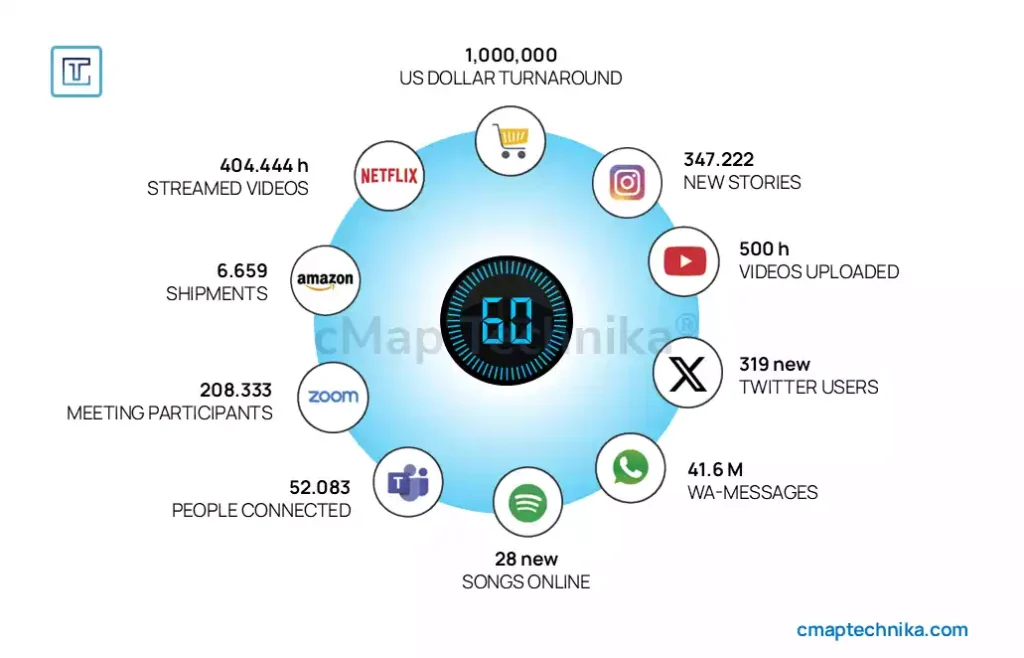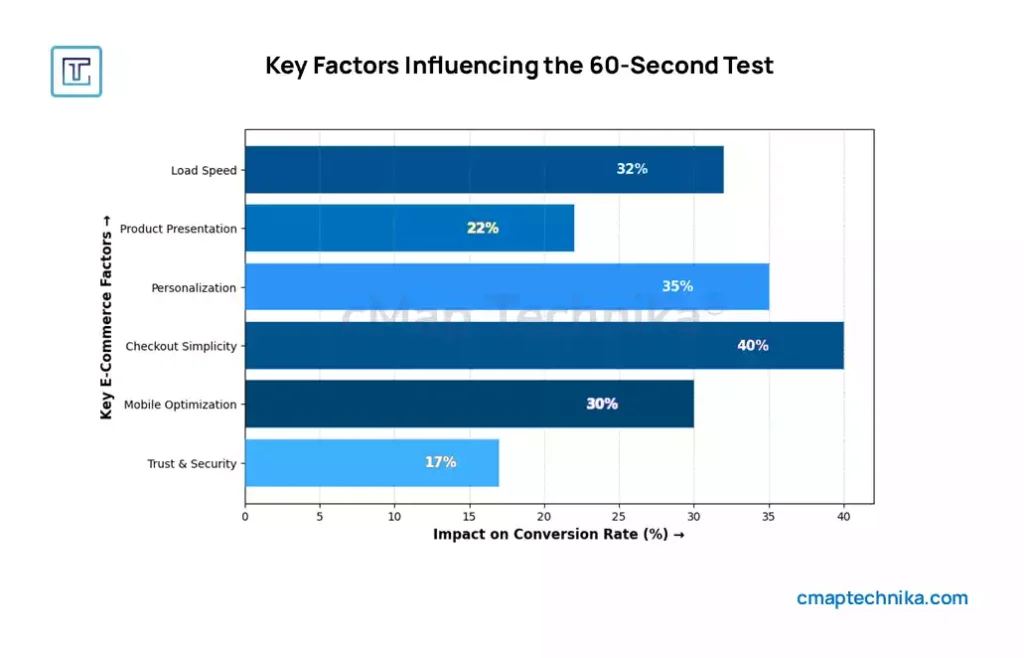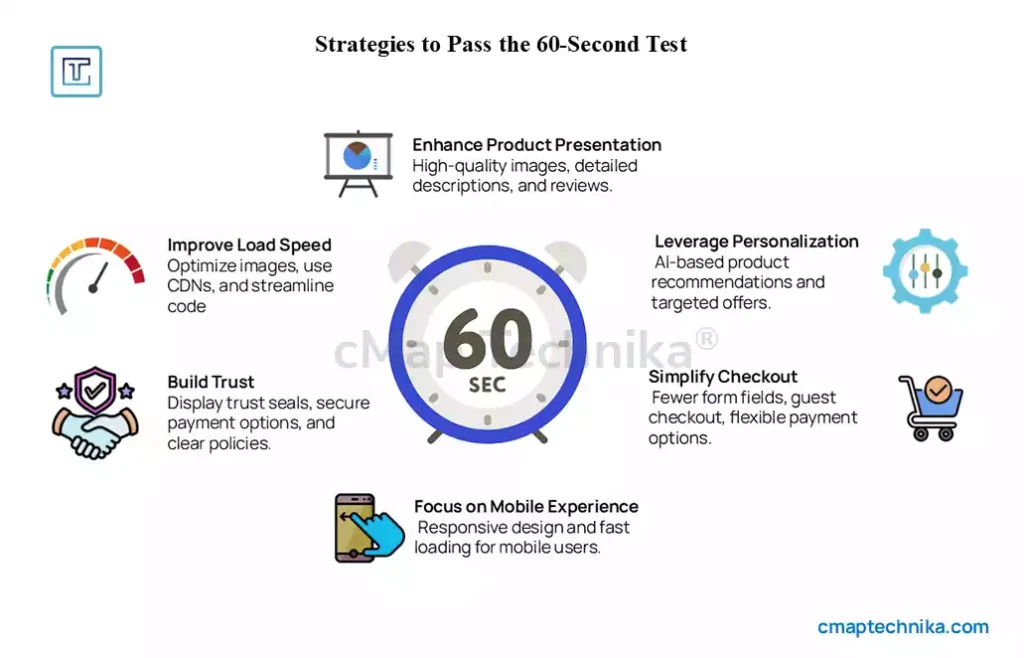Introduction

In the highly competitive landscape of e-commerce, success is often determined by the ability to capture and retain customer attention within the first 60 seconds of interaction. Research indicates that users form an impression of an online store within 0.05 seconds, and approximately 55% of visitors will leave a website if it takes longer than three seconds to load. This creates a narrow but critical window for e-commerce brands to establish credibility, engage users, and drive conversions. The “60-second test” refers to the pivotal first minute during which customers subconsciously decide whether to continue exploring a site or abandon it altogether.
This article explores the key elements that influence e-commerce success within this short window, including user experience (UX), website performance, product presentation, and personalized engagement. It examines research-backed insights, case studies, and industry best practices to outline how leading brands optimize the customer experience to pass the 60-second test.
The Science Behind the 60-Second Test
Customer behavior in e-commerce is heavily influenced by cognitive biases and emotional triggers. Research in consumer psychology reveals that customers rely on a combination of rational analysis and emotional responses when making purchase decisions. The first impression a customer forms about a website is based on:
- Visual appeal – Clean design, intuitive navigation, and high-quality imagery improve perceived trust and professionalism.
- Load speed and responsiveness – Studies show that a delay of one second in page load time can reduce conversion rates by 7%.
- Ease of navigation – A cluttered homepage or confusing menu structure increases bounce rates.
- Perceived value – Customers want to see immediately why the product or service is valuable.
A 2023 study by Baymard Institute found that 68% of online shopping carts are abandoned due to complex checkout processes, hidden fees, or poorly designed payment gateways. Successful e-commerce brands anticipate these friction points and address them proactively.
Key Factors That Influence the 60-Second Test

1. Website Speed and Performance
Page load time is one of the most critical determinants of e-commerce success. Research shows that a two-second delay in page loading can increase bounce rates by up to 32%. Google’s algorithm also prioritizes site speed when ranking search results, meaning that slow websites face disadvantages in both user retention and visibility.
Example:
In 2022, Walmart conducted an internal study and found that improving page load time by just one second increased conversion rates by 2%. Similarly, Amazon estimated that every 100ms reduction in load time increased sales by 1%. These improvements were achieved by reducing image sizes, optimizing code, and leveraging content delivery networks (CDNs).
2. Product Presentation and Clarity
Customers expect detailed product information presented in a clean, organized format. High-quality images, customer reviews, and detailed product specifications build trust and influence purchase decisions.
Example:
Zara revamped its online product pages in 2021 by increasing image resolution and adding video previews. This allowed customers to view clothing items from multiple angles and better understand fabric texture and fit. The change resulted in a 22% increase in online sales and a 15% reduction in return rates.
Furthermore, clear product descriptions, size guides, and customer reviews reduce uncertainty and encourage confident purchasing decisions.
3. Personalization and Targeted Recommendations
Modern e-commerce platforms use AI and machine learning to personalize the customer experience. Personalized recommendations based on browsing history, search behavior, and past purchases significantly improve customer engagement and conversion rates.
Example:
Netflix’s recommendation algorithm, although not directly e-commerce-focused, demonstrates the power of AI-driven personalization. By analyzing viewing patterns, Netflix generates personalized content suggestions that account for over 75% of its watched content. Similarly, Amazon’s “Recommended for You” feature accounts for approximately 35% of total revenue.
4. Streamlined Checkout Process
Complex or lengthy checkout processes are one of the primary reasons for cart abandonment. Customers expect a simple, intuitive checkout experience with minimal form fields, clear pricing, and flexible payment options.
Example:
In 2020, Shopify introduced “Shop Pay,” a one-click checkout feature that reduced checkout times by 40%. This improvement led to a 1.91x higher conversion rate compared to other payment methods. Offering guest checkout options and storing customer information for future use also improves the overall experience.
5. Mobile Optimization
With over 55% of global e-commerce transactions occurring on mobile devices, ensuring a seamless mobile experience is critical. Mobile-optimized websites, fast load times, and easy navigation contribute to higher engagement and sales.
Example:
In 2019, ASOS overhauled its mobile app to improve load times, simplify navigation, and enhance search functionality. Mobile sales increased by 30% within six months, demonstrating the importance of mobile-first design.
6. Trust and Security
Customers are highly sensitive to trust signals when making online purchases. Lack of security badges, unclear return policies, or suspicious payment gateways increase cart abandonment rates.
Example:
In 2021, PayPal reported that checkout pages displaying trust seals (such as Norton or McAfee) increased customer confidence, resulting in a 17% higher completion rate. E-commerce brands that implement SSL certificates, clear refund policies, and customer service options enhance trust and conversion rates.
Case Study: How Warby Parker Passed the 60-Second Test
Warby Parker, a direct-to-consumer eyewear brand, built its e-commerce success on a streamlined, customer-focused model. From the outset, the company prioritized:
- Fast load times – Warby Parker’s site consistently loads in under two seconds, reducing bounce rates.
- Virtual try-on tools – By integrating AR technology, customers can try on glasses virtually, increasing confidence in purchase decisions.
- Clear product information – Each product listing includes detailed specifications, multiple images, and customer reviews.
- Simple checkout process – Guest checkout and multiple payment options make the process easy and intuitive.
Warby Parker’s focus on speed, clarity, and personalization resulted in a 35% higher conversion rate compared to industry averages.
Strategies to Pass the 60-Second Test

- Improve Load Speed – Optimize images, use CDNs, and streamline code to reduce loading time.
- Enhance Product Presentation – Use high-resolution images, detailed descriptions, and customer reviews.
- Leverage Personalization – AI-driven product recommendations and targeted marketing increase engagement.
- Simplify Checkout – Reduce form fields, enable guest checkout, and offer flexible payment methods.
- Focus on Mobile Experience – Ensure responsive design and fast load times for mobile users.
- Build Trust – Display trust seals, clear policies, and secure payment gateways.
Conclusion
E-commerce success is often determined within the first 60 seconds of customer interaction. Brands that pass the 60-second test focus on speed, simplicity, and customer-centricity. Leading companies such as Amazon, Warby Parker, and ASOS have demonstrated that enhancing site performance, streamlining product presentation, and integrating AI-driven personalization can significantly boost engagement and conversion rates. In a market where customer expectations continue to rise, passing the 60-second test is not just an advantage—it’s a necessity for survival and growth in the competitive e-commerce landscape.






